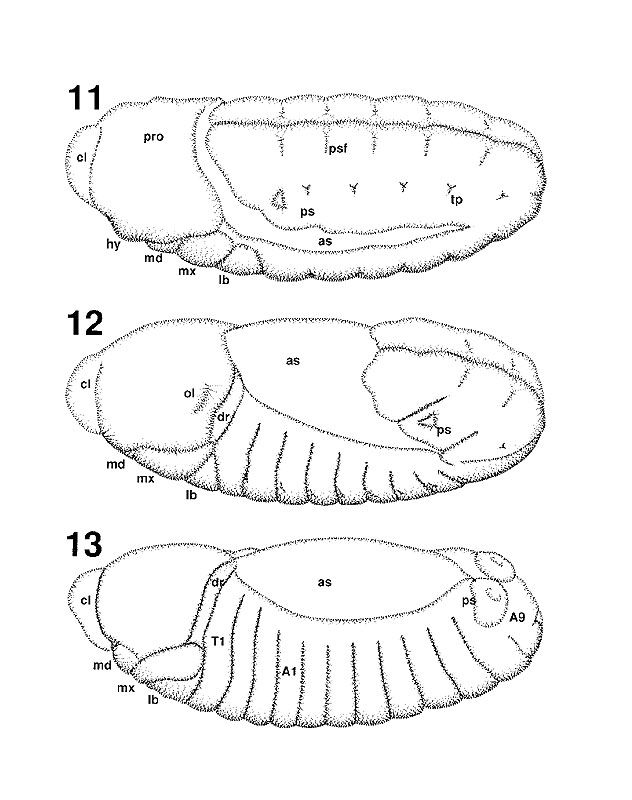THE STAGES OF EMBRYOGENESIS
Select image to enlarge in new window
 |
The Stages of Embryogenesis page 2 | 3 | 4 Stage 11: This stage is characterized by the parasegmental furrows (psf) that subdivide the germ band into metameric units. The first three segments (md, mandible; mx, maxilla; lb, labium) appear as conspicuous protuberances, the gnathal buds. The clypeolabrum (cl) and hypopharyngeal lobe (hy) are protuberances of the procephalon (pro) that mark the rudimentary first (labral) and third (intercalary) head segment. Tracheal pits (tp) appear in segments T2 to A8. The dorsal part of A8 gives rise to an additional invagination from which the posterior spiracle (ps) develops. The salivary gland invaginates from the ventral labium.
Stage 12: This stage begins when the germ band starts to retract and ends when germ-band retraction is complete. The external landmarks of the ectoderm (i.e., metameric furrows, gnathal buds, tracheal pits) that had appeared in stage 11 remain basically very similar throughout stages 12 and 13. A prominent feature of the head of a stage-12 embryo is the invaginating optic lobe (ol) and the dorsal ridge (dr), a protuberance formed by the dorsal part of the gnathal segments. During stage 12, important morphogenetic events take place in the endoderm and mesoderm.
Stage 13: The end of germ-band retraction marks the stage in embryogenesis at which cells in most organ primordia begin to differentiate, as testified by the expression of specific structural and biochemical markers. The main morphogenetic events that shape the embryonic surface after germ-band retraction are dorsal closure and head involution. During dorsal closure, the epidermal primordium stretches in the transversal axis, thereby gradually closing the gap that had so far persisted in the dorsal germ band. Dorsal closure begins anteriorly and posteriorly and progresses to mid levels of the germ band. By the end of stage 13, only A9 and the gnathal segments (i.e., the dorsal ridge) are closed. Head involution, which begins with stage 14, is a complex movement during which most head structures (i.e., the procephalon and the gnathal segments) vanish from the surface into the interior of the embryo. (as) Amnioserosa; (A1, A9) first and ninth abdominal segment, respectively; (T1) first thoracic segment.
|
